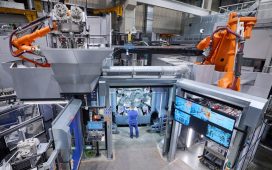Rivian revealed its next electric vehicle, the R2, a more affordable SUV that the company is counting on having a much broader appeal than its stylish — and expensive — R1T trucks and R1S SUVs.
The R2 won’t go into production until the first half of 2026, but when it does it will come with an estimated range of over 300 miles, a 0–60mph time of three seconds, and a starting price of $45,000 — placing it slightly below the current average selling price for a new internal combustion vehicle. The price could be even lower if it ends up qualifying for the $7,500 federal EV tax credit.
Image: Andrew Hawkins / The Verge
Interested buyers can reserve an R2 starting today for $100, with deliveries expected to begin in the first half of 2026. Whether Rivian can stick to that schedule will be a central challenge for the EV company. For the R1T truck, for example, some of the first customers were forced to endure long wait times before receiving their EV.
Making an electric vehicle that’s affordable to a broader swath of people is crucial for Rivian’s long-term viability. The company’s R1T truck starts at $70,000, while the R1S SUV kicks off at $76,000 and can climb as high as $88,000. Rivian needs a less expensive vehicle if it’s to successfully compete with Tesla and other legacy automakers who currently dominate the sales chart.
Since coming out of stealth in 2018, the company has positioned itself as a maker of adventure vehicles that are ideal for camping and off-road antics. Sure, Rivian’s vehicles are mostly used for more mundane excursions, like trips to Home Depot and soccer practice. But Rivian knows that some of the most popular vehicles on the road today are trucks and SUVs that are dirt-road and towing aspirants.
Many of the details had leaked before today’s launch, like the specs, the location of the event, and even a blurry image of the R2 itself. But Rivian still had a lot to add during the event.
The Rivian R2 will come in single-, dual-, and tri-motor variations. The vehicle will come with Tesla’s NACS port built natively into the vehicle. Interestingly, the charge ports will be in the rear of the vehicle, as compared to the front as with the R1T and R1S. This is likely because Tesla puts its ports in the rear for better access to the company’s Superchargers.
The R2 will feature Rivian’s new 4695 cylindrical battery cells
The R2 will feature Rivian’s new 4695 cylindrical battery cells, which is 15 mm taller than Tesla’s 4680 cells. And the company is promising a more powerful computer, complimented by a sensor suite that includes 11 cameras and five radars. The R2 will have “dramatically enhanced autonomous capabilities,” though the company didn’t specify what level of automation it was shooting for.
It’s 185.6 inches in length, which is less than two inches shorter than a Tesla Model Y or about 15 inches less than an R1S. Its width is 75 inches, or 84.4 inches with the mirrors, and the height is 66.9 inches. The wheelbase is 115.6 inches long.
There’s a substantial frunk (front truck) — Rivian described it as “roomy” — which can hold a carry-on suitcase plus a backpack, or up to six reusable grocery bags. Keeping with its “adventure” ethos, the R2 will also feature a nifty bike mount system that can connect easily with the vehicle’s rear accessory ports.
The interior of the R2 is a big change from the R1 lineup. Noting that they’ve been criticized for failing to include a glove compartment in the R1T and R1S, Scaringe said they “overdelivered” with the R2, which will feature two gloveboxes. Both appear to be fairly massive, looking ready to take all the gloves you have.
The steering wheel also has a new feature: two giant scroll wheels. The wheels will have dynamic haptic feedback, but Scaringe says they need to be used to be really appreciated. “It takes our existing scroll wheel and really up levels it to a degree that’s hard to fully appreciate unless you’re sitting in the car,” he said.
The rear seats fold down for additional space — and the front seats fold down as well. Scaringe said this would be an ideal configuration for anyone interested in sleeping overnight in their Rivian R2.
The rest of the interior looks to be simplified, which makes sense for a more mass-market vehicle. The infotainment system will run on Rivian’s own operating system, and like Tesla, won’t support Apple CarPlay or Android Auto. And the door still features a built-in flashlight on the side, a feature carried over from the R1 vehicles.
In addition to the R2, the company also announced the R3, a sportier compact SUV, and its performance variant, the R3X. Rivian said the R3 would be even less expensive than the R2, but didn’t release the exact price. Reservations for the R3 will go live at a later date.
“These represent our future,” Rivian CEO RJ Scaringe said during the event. “These represent what we’ve been building to… with the R1 products and in positioning Rivian to take that further and make that more accessible to more people.”
In unveiling its plans to put its next vehicle into production, Rivian faces an existential test. The company reported losing $1.58 billion over the last three months of 2023, bringing its net annual losses to $5.4 billion. It also announced plans to lay off 10 percent of its salaried employees, the third such round of layoffs in the last two years. It is planning to shut down its factory in Normal, Illinois, for several weeks to bring improvements to the R1 line. And it will soon break ground on a new $5 billion factory in Georgia.
The R2 can’t save Rivian on its own. But it will certainly play a major role in keeping the company afloat.












